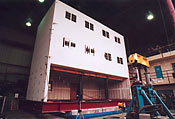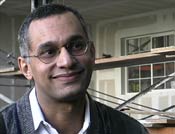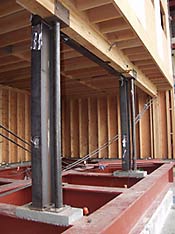|
 |

VIDEOS:
Three-story apartment building shakes, rattles, and
rolls during a seismic test that simulated a 1994 Northridge-scale
earthquake Peg Skorpinski photo
|
| |

VIDEO:
UC Berkeley civil engineering assistant professor Khalid
Mosalam describes the rationale for the test.
|
| |

A
new steel frame, designed to resist seismic forces,
was installed to simulate the typical way buildings
like this have been retrofitted. Such retrofits often
include steel beam supports.
|
Shaken,
not stirred: UC Berkeley engineers subject three-story woodframe
structure to multiple earthquake forces
21
December 2001
By
Sarah Yang, Media Relations
BERKELEY
— In a testament to the value of high-quality construction,
a full-scale three-story woodframe apartment building sustained
only minor to moderate damage after University of California,
Berkeley, engineers put it through a series of powerful shake
tests.
In the
earthquake simulation conducted Dec. 21 at UC Berkeley's Richmond
Field Station, the full-scale building with tuck-under parking
experienced the same ground motions recorded during the 1994
Northridge earthquake. One of the more powerful of the four
tests performed generated forces 20 percent greater than those
at Canoga Park, a city in the San Fernando Valley located
less than 10 miles south of the quake's epicenter.
A similar
experiment was conducted more than a week ago when steel frame
retrofits had been installed in the building. In that earlier
experiment, "the structural performance of the building was
excellent," said Khalid Mosalam, assistant professor of civil
engineering at UC Berkeley and lead investigator of the experiment.
"Current seismic building codes call for these woodframe structures
with tuck-under parking to be built with steel frames, but
as a retrofit, that had never been put to the test until last
week."
Mosalam
attributed the building's performance on Dec. 12 to the retrofitting
and, in large part, to the finish materials that stiffened
the structure's walls and joints. He explained that the steel
frame used to retrofit the building helped minimize twisting
motions, while finish materials — including the stucco exterior
and gypsum board — helped minimize the building's lateral
movements during the quake.
When tested
without the retrofit, the finishing materials of the structure
began to show noticeable cracks, nail pullouts and sliding
and separation at the building base.
While the
December test results were encouraging overall, Mosalam did
note that they could not simulate the effects of age or neglect
on a building. "We didn't have termites, mold or moisture
weakening the building," he said. "If a building is not maintained
properly, or if the stucco is applied improperly, the risk
for damage will likely be much greater."
The shake
test is part of a larger $6.9 million woodframe project funded
by the Federal Emergency Management Agency through the California
Office of Emergency Services after the magnitude 6.7 Northridge
earthquake. The Consortium of Universities for Research in
Earthquake Engineering (CUREE) manages the project under subcontract
to the California Institute of Technology.
In the
Northridge quake, 24 people died as a result of damage to
woodframe buildings, including 16 people in one building with
tuck-under parking in the Northridge Meadows apartment complex.
In addition, damage to woodframe structures caused more than
$20 billion in property loss, exceeding the financial loss
from any other single type of building construction from the
quake.
"We're
trying to find ways of preventing such destruction from occurring
again in the next earthquake," said Bob Reitherman, executive
director of CUREE. "We'll be using results from these tests
to evaluate existing retrofit ordinances and to develop improved
building codes and standards."
During
the 1960s and early 1970s, tens of thousands of woodframe,
multi-unit residential buildings were constructed with tuck-under
parking in California as a way to use space more efficiently.
The tuck-under parking design dominates multi-unit residential
buildings in the East Bay, particularly in Berkeley and Oakland,
said Richard Eisner, regional administrator of the California
Office of Emergency Services.
However,
such a design creates a large open area on the ground level
that provides less support for the building, possibly leading
to severe damage and collapse during a strong earthquake.
"Ultimately, how we construct our buildings determines whether
people are killed in earthquakes," said Eisner.
The experiments
were conducted on the nation's largest earthquake simulator,
capable of moving in three dimensions simultaneously. The
three-story building was also the largest structure ever tested
on a shake table in the country.
"This latest
test shows the importance of quality control during a building's
construction," said John Hall, professor of civil engineering
at the California Institute of Technology and manager of the
CUREE-Caltech Woodframe Project. "When constructed well, many
buildings can survive significant ground forces."
In practice,
however, shortcuts are sometimes taken during construction
that compromise the stabilizing effects of finish materials,
said Hall. "When you install the stucco exterior, everything
from the amount of plywood used to the number and size of
nails makes a difference in the strength of the building,"
he said.
The structure
tested by UC Berkeley engineers was constructed in accordance
with the uniform building code from 1964, but the installation
of steel frame retrofits for such buildings are not currently
required by law.
"What we'd
like to see is how the building would perform with other types
of ground motions, particularly those of longer duration,"
said Mosalam. More tests are planned for the first week of
January.
"We expect
that results from these tests will eventually be used to design
safer buildings, and, in the end, to help save lives," said
Mosalam.
Related
story:
The UC
Berkeley shake test was also an early demonstration of how
inexpensive, wireless remote sensors
can provide valuable feedback on the structural integrity
of a building after an earthquake.
|